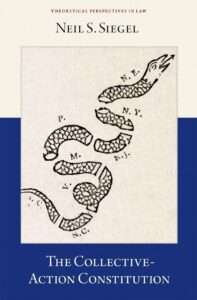A Collective-Action Theory of the Constitution's Federal Structure


Part II of The Collective-Action Constitution develops a collective-action theory of the Constitution’s federal structure and identifies limits of this theory.
Chapter Three examines the states’ potential role in solving collective-action problems that arise for them by forming interstate compacts and other agreements. The chapter also explains, however, why the third clause of Article I, Section 10 (if not doctrine to date) presumptively bars interstate compacts and requires congressional consent to overcome the presumption. Proposed compacts may undermine federal supremacy or harm sister states, and states may disagree about whether compacts solve or cause collective-action problems. The Constitution does not compel one answer to such questions, which are also historically contingent and normative, not just scientific or technical. Rather, the Constitution assigns main responsibility for deciding them to Congress, where, as Chief Justice Marshall explained in McCulloch v. Maryland (1819), the interests of all states and people are represented.
In addition to potentially raising normative concerns, interstate compacts are difficult to form. Many parties within compacting states must approve, and compacts require unanimous agreement among the compacting states. Moreover, impediments to collective action tend to increase sharply with the number of states that must act together. In general, if proposed compacts must encompass many states to accomplish their purposes, free rider, holdout, and disagreement problems are likely to paralyze them. This is a lesson of early American history and subsequent experience, and it helps explain why, according to the book’s arithmetic, compacts usually involve few states and why only around 200 exist today.
Chapter Four argues that, because nationalist Founders did not expect the states regularly to be able to act collectively, the Constitution empowers Congress to solve many multi-state collective-action problems. The constitutional text and structure reflect the conviction that the federal government operating through (super)majority rule will be more likely to find solutions that elude states trying to cooperate or coordinate through unanimity rule. George William Van Cleve writes in his history of the Confederation period that the Constitution emerged from “the states’ and sections’ willingness to confer fundamental new powers on the national government and to permit them to be exercised by majority vote.” Thus, the eighteen clauses of Article I, Section 8, mainly authorize Congress to address various kinds of collective-action problems for the states.
Foremost among the Section 8 powers is Congress’s taxing authority—and, relatedly, its powers to spend and borrow. After detailing the main structural problems with the Articles of Confederation and the ways in which nationalist Framers sought to address them in drafting Resolution VI of the Virginia Plan and Section 8, this chapter analyses Congress’s powers to tax, spend, and borrow. Its theory of Congress’s tax power was largely adopted in NFIB v. Sebelius (2012), and its account of psychological externalities justifies broad federal power to spend for the “general Welfare.”
Chapter Five leverages collective-action reasoning to explain the origins of the Interstate Commerce Clause, critique the Supreme Court’s formal distinctions in interpreting this clause, and identify a functional replacement: the distinction between collective and individual action by states. This chapter reads the Interstate Commerce Clause textually and structurally as authorizing legislation where Congress has identified a multi-state collective-action problem caused by interstate spillovers that produce economic (not psychological) effects. Under this approach, Gibbons v. Ogden and decisions from 1937 to the 1990s are correctly decided. A collective-action approach also explains why the contemporary Court has decided most interstate-commerce cases correctly, albeit for reasons other than what its doctrine states. This chapter next questions the categorical nature of the Court’s anti-commandeering principle and defends its dormant commerce doctrine.
The chapter then leverages collective-action logics to illuminate the Founding history and scope of the Foreign and Indian Commerce Clauses. The states must act collectively, not individually, to act effectively in their commercial relations with other nations. Moreover, “Commerce” in these clauses should be interpreted how it is structurally best understood in interstate-commerce cases: to include interactions and affairs outside markets in addition to trade and other economic activities. Finally, this chapter discusses the principle that valid federal law supersedes conflicting state law. Preemption flows directly from a collective-action account of the Constitution.
Chapter Six examines the rest of Section 8. It begins with the collective-action rationales for authorizing Congress to define and punish certain offenses with national-security implications and provide for the nation’s defense. It then examines the postal and intellectual-property powers. Like the military-defence clauses, both powers enable Congress to internalize positive interstate externalities. The chapter next explains why Congress can require national uniformity in regulating naturalization and bankruptcy, after which it considers standards, currency, and counterfeiting, which also implicate concerns about the collective costs of divergent state regulations. The chapter concludes with the powers to create lower federal tribunals and govern federal enclaves. These powers not only facilitate federal administration but also solve multistate collective-action problems.
Chapter Seven examines Articles II, III, and VI. Federal laws that aim to solve multi-state collective-action problems would have little impact without their enforcement against states and private parties that violate or seek to undermine them. Likewise, constitutional or congressional prohibitions on state legislation that undermines federal solutions or causes collective-action problems for the states would be largely meaningless without enforcement of these prohibitions to ensure federal supremacy. Articles II and III create independent executive and judicial branches and authorize them to enforce federal law.
Article II also empowers the President to energetically conduct diplomacy and national-security operations—functions that states and members of Congress could not perform without overcoming daunting collective-action problems. Article III gives the federal judiciary its own responsibilities in foreign relations and national security, as well as domestic peace. By umpiring international or interstate disputes, including when attempts to form interstate compacts fail, federal courts solve or prevent collective-action problems for the states. Article VI’s Supremacy Clause and oath requirement for state officials advance the same supremacy objective as Article III by helping ensure the efficacy of the solutions to collective-action problems provided in the Constitution, federal statutes, and treaties, and by reinforcing the prohibitions on state conduct that compromise such solutions or generate collective-action problems.
Chapter Eight analyzes the Constitution’s under-appreciated role in defining the relationship among the states themselves. Article IV’s two initial sections either limit what states may do or empower Congress to act. The Full Faith and Credit, Effects, Privileges and Immunities, and Extradition Clauses promote political and economic union by preventing collective-action problems for the states. Distressingly, the same was true of the Fugitive Slave Clause. The collective-action rationale for federal power to enforce this clause underscores the significance of constitutional rights as limits on what Congress can do, and states cannot do, to solve or prevent multistate collective-action problems.
Article IV’s third section turns from the movement of persons across state lines to control over territory. The Territories Clause gives Congress exclusive power to dispose of and regulate federal lands and property, and the Admissions Clause gives Congress exclusive power to admit new states. These clauses both empower Congress to solve collective-action problems for the states and prevent states from causing them. Their placement together may reflect an original expectation that federal territories would become states. That has not always happened, however, which raises troubling questions about the democratic legitimacy of contemporary American empire.
Chapter Nine examines a main modern role of the Constitution: protecting individual rights against states. Collective-action reasoning helps explain some rights, including those secured by dormant commerce doctrine and the Full Faith and Credit Clause. This chapter identifies additional rights that both protect individual liberty or equality and prevent states from causing collective-action problems. They are the rights protected by the Privileges and Immunities and Guarantee Clauses, and the right to enter and leave other states.
Enforcement of most rights does not, however, primarily reflect collective-action logics. The main structural achievement of the Reconstruction Amendments was to empower federal courts and Congress to regulate states’ internal policy choices on certain subjects regardless of collective-action problems facing states. Most rights exist principally to protect people from unconstitutional action by their states, not to prevent states from causing collective-action problems. Although The Collective-Action Constitution cannot primarily explain most such rights, it helps account for those that protect the democratic process. It also provides secondary justification for equality rights, which must be protected to make meaningful the right to travel through states for minority groups.
The post A Collective-Action Theory of the Constitution’s Federal Structure appeared first on Reason.com.
Source: https://reason.com/volokh/2024/06/06/a-collective-action-theory-of-the-constitutions-federal-structure/
Anyone can join.
Anyone can contribute.
Anyone can become informed about their world.
"United We Stand" Click Here To Create Your Personal Citizen Journalist Account Today, Be Sure To Invite Your Friends.
Humic & Fulvic Liquid Trace Mineral Complex
HerbAnomic’s Humic and Fulvic Liquid Trace Mineral Complex is a revolutionary New Humic and Fulvic Acid Complex designed to support your body at the cellular level. Our product has been thoroughly tested by an ISO/IEC Certified Lab for toxins and Heavy metals as well as for trace mineral content. We KNOW we have NO lead, arsenic, mercury, aluminum etc. in our Formula. This Humic & Fulvic Liquid Trace Mineral complex has high trace levels of naturally occurring Humic and Fulvic Acids as well as high trace levels of Zinc, Iron, Magnesium, Molybdenum, Potassium and more. There is a wide range of up to 70 trace minerals which occur naturally in our Complex at varying levels. We Choose to list the 8 substances which occur in higher trace levels on our supplement panel. We don’t claim a high number of minerals as other Humic and Fulvic Supplements do and leave you to guess which elements you’ll be getting. Order Your Humic Fulvic for Your Family by Clicking on this Link , or the Banner Below.
Our Formula is an exceptional value compared to other Humic Fulvic Minerals because...
It’s OXYGENATED
It Always Tests at 9.5+ pH
Preservative and Chemical Free
Allergen Free
Comes From a Pure, Unpolluted, Organic Source
Is an Excellent Source for Trace Minerals
Is From Whole, Prehisoric Plant Based Origin Material With Ionic Minerals and Constituents
Highly Conductive/Full of Extra Electrons
Is a Full Spectrum Complex
Our Humic and Fulvic Liquid Trace Mineral Complex has Minerals, Amino Acids, Poly Electrolytes, Phytochemicals, Polyphenols, Bioflavonoids and Trace Vitamins included with the Humic and Fulvic Acid. Our Source material is high in these constituents, where other manufacturers use inferior materials.
Try Our Humic and Fulvic Liquid Trace Mineral Complex today. Order Yours Today by Following This Link.






